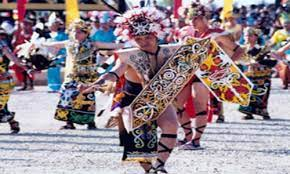Adahobi, Monong Dance is a traditional Dayak dance in the highlands of West Kalimantan Province. Monong dance is also often referred to as the manang dance.
This traditional dance is a healing dance or disease repellent performed when its citizens are sick.
Monong dance was first performed in the early 1800s and has been passed down from generation to generation since then.
The word “monong” means “one leg” in Indonesian, which refers to the fact one foot when they perform this dance.
In this article, we will explore further from the history to the meaning behind this beautiful traditional dance!
History of Monong Dance
At first, the monong dance was a dance performed to heal residents, performed by Dayak shamans by reciting mantras while dancing.
During the dance process, sick family members join the dance guided by a shaman.
This dance is a ritual dance that is usually performed by the Dayak tribe to ask God for healing so that people who are sick will be healed immediately.
Over time, the monong dance has also changed, in the sense that this dance is not only used as a healing ritual, this dance is also a means of entertainment and a place for preserving traditional Dayak arts.
And today, Monong Dance is a traditional dance that has become part of Indonesia’s cultural heritage originating from West Kalimantan Province.
Apart from being a ritual ceremonial dance, this dance is often also performed in traditional Bemenang, Balian, welcoming guests, or other traditional ceremonies.
Monong Dance Function
Based on history, Monong Dance functions as a medium or dance ritual to treat its citizens who are sick.
The method of treatment is quite unique, the selected Dayak shamans will dance while reciting healing spells. In the mantra there is the meaning of asking God for healing.
In addition to functioning as a healing ritual, this dance also functions as a repellant and an antidote to disease.
And at this time, the dance is not only limited to sacred rituals, now it has developed into a dance that has an attraction in terms of entertainment.
Because of this, this dance is also used as a dance to welcome guests and as a place to preserve Dayak art and culture.
The Uniqueness of Monong Dance
Monong dance has a uniqueness that lies in the pounding of the feet and hands during the reading of Dayak mantras.
Although not everyone understands the spell, and only the elders can understand it, but that is what makes it interesting.
It is felt that the sacredness contained in the Monong dance is very thick.
And the purpose and purpose of the dance is to ask for healing for people who are sick.
The Meaning of Monong Dance Movement
Movement in Monong Dance focuses on when the shaman is performing a healing ritual.
The movement is thick with mystical nuances, especially when the shaman dances while reciting healing spells.
Shamans and sick family members will dance using special properties for rituals.
This dance is also accompanied by traditional Dayak musical instruments which add to the mystical atmosphere.
Monong Dance Floor Pattern
Every traditional dance will use a dance floor pattern to make the dancer’s movements more organized.
While dance generally uses straight and horizontal floor patterns, monong dance uses straight and curved floor patterns.
Monong Dance Accompaniment Music
Like other traditional dances, Monong dance is also accompanied by musical instruments. Musical accompaniment makes the atmosphere more lively and adds to the mystical atmosphere.
And the main musical instrument that is most often used is called the Sape.
Sape is a distinctive musical instrument that accompanies almost all Dayak dances. This musical instrument is also known to the area of West Kutai, Malinau to Samarinda.
Sape has a shape like a guitar, and how to play it is also picked. This musical instrument is made of Kita Wood or Adau Wood.
Sape musical instrument can produce 2 tones, namely Sakpakok and Tubunsitun.
Tubunsitun is a tone that has a slow tempo, but there are characteristics. While Sakpakok is the exact opposite, the tempo is faster and dynamic.
Monong Dance Dress
The monong dancers will wear the typical Dayak clothing of West Kalimantan. So what does the outfit consist of? Here’s the explanation.
• Headband
• Slope radius
• Panties
• Glass necklace
• Sumping lawe
• A sword or saber
• Belt
• Shoulder training
• A typical Dayak shield
• Sampur cinde
• Timing effect
• Boro mote
Monong Dance Property
It’s not enough to just wear typical Dayak clothing, the dancers are also equipped with props and accessories that will be used for ritual events.
The accessories and properties are in the form of:
1.Mandau
Mandau or a kind of machete is a sharp weapon typical of the Dayak tribe. Unlike the ordinary machete, on the blade of the Mandau there are carvings that are coated with brass.
2. Shield
The shield of the Dayak tribe named Talawang, is a shield made of iron wood or ironwood.
This shield is rectangular, pointed at the top and bottom. Has a length of 1-2 meters with a width of 50 cm.
3. Shawl
A typical Dayak scarf is used when there is a dance to welcome guests. A scarf will be draped over the guest.
The need for digital IT is needed in daily activities, Bead IT Consultant is the right choice as your partner, visit our website by clicking this link: www.beadgroup.com

